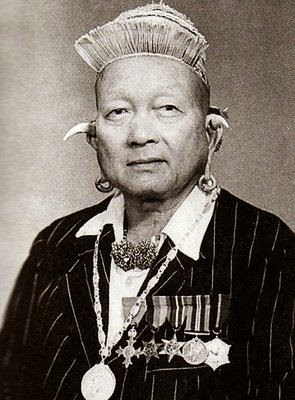 |
| Young girls show typical dress of Kayan girls. Location: Sarawak, Borneo. |
The reason given for the emigration is overcrowding (Hang Nyipa 1956), and ecological degradation was advanced.In the late 1890s, the Dutch explorer Anton Nieuwenhuis found that even far up the tributaries there was no primary forest, and only clumps of secondary growth amid rank grasses (Nieuwenhuis 1901:1061).
This situation is relatively rare in central Borneo because overall population densities are so low, and it demonstrates how numerous the Kayan were when the out-migrations began,sometime in the 18th century.
They crossed the mountain chain onto the Sarawak side in Two Parties (Kayan Baram & Kayan Belaga)
Kayan Belaga( Moved into the far headwaters of the Rejang)
Kayan Baram( moved into South of the Baram Watershed)
and by 1800s, their hegemony over the indigenous peoples of the region was apparently well established.From there some moved on again into Baram about 1830.
Meanwhile,other Kayan arrived directly from the Apo Kayan (Rousseau 1990:331-2),within ashort time , a series of large Kayan Communities were established ,effectively occupying the entire middle reaches of the Baram.....SOURCE:the life of the longhouse..
 |
| SARAWAK STAMP:KAYAN GIRL & BOY (BROOKE DYNASTY) |
 |
| A Kayan man and woman show traditional dress found in Sarawak. |
 |
| Decorating the coffin of an aristocratic woman(Maran)-LONG AMPUNG ,Apo Kayan in 1963 |
 |
| The interior of a traditional Kayan house. Location: Sarawak, Borneo. Photographer: HARRISON W. SMITH/National Geographic Stock |
 |
| Kayan-Dayak women 1898 |
 |
| Kayan Ladies with Sun-Hats |
 |
| young Kayan girls stretch their earlobes as a sign of beauty. Location: Sarawak, Borneo |
 |
| There used to exist a sport of wrestling among the Kayan( PAYU). In this the loincloth, as in sumo, was important, as a place to get a hold on. [ photograph by Charles Hose, ca. 1900.] |
 | ||
| KAYAN LONGHOUSE | |
 |
| Kayan people escort the Kayan chief to the banks of a river. |
 |
| Kayan men perform traditional sword dance and play a reed instrument |
related post:Learning-kayan-langauage-from-sarawak












